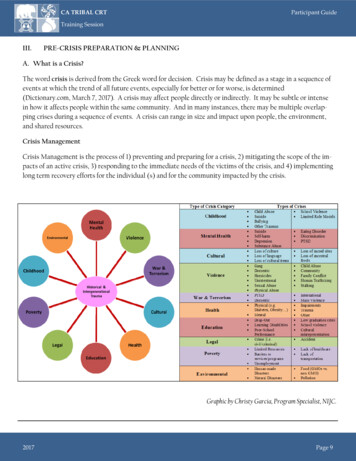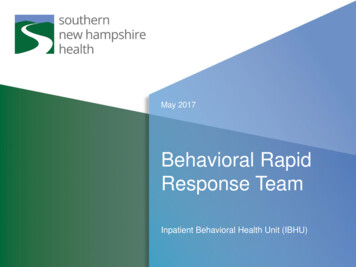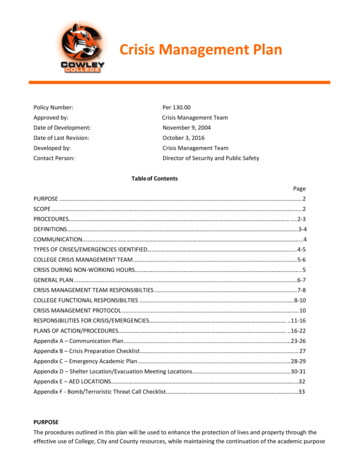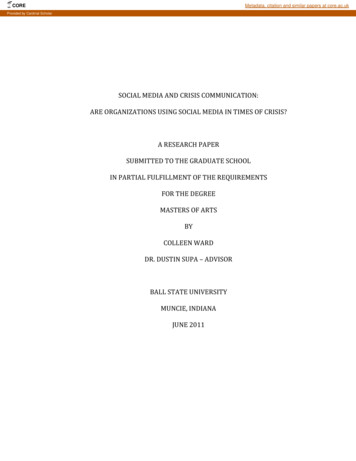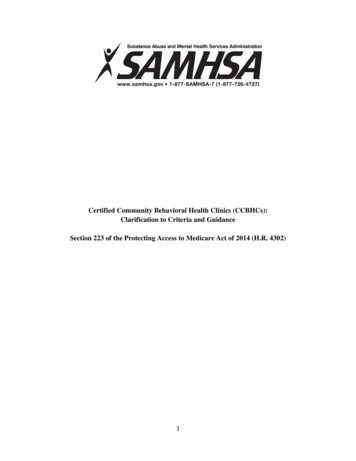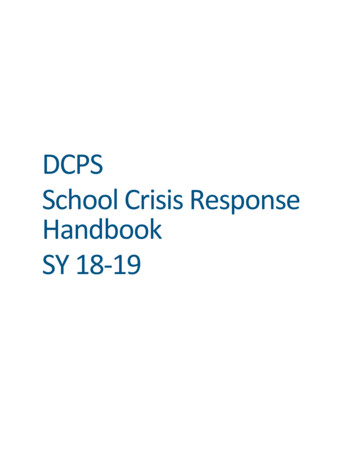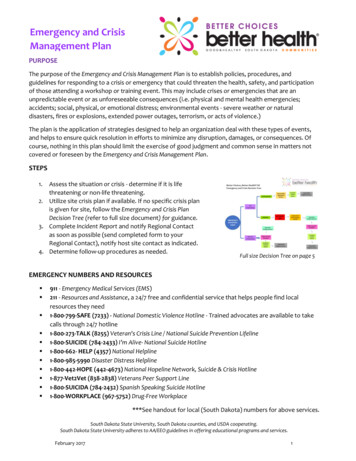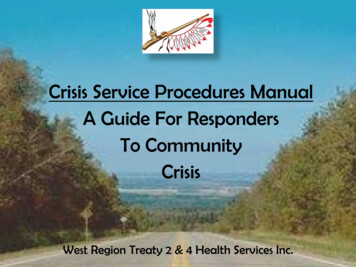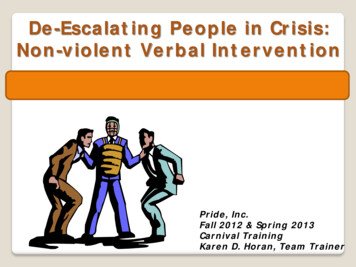
Transcription
De -Escalat in g Pe op le in Cr isis:Non -v iole n t Ve r b al In t e r v e n t ionPr id e , In c.Fall 2 0 1 2 & Sp r in g 2 0 1 3Car n iv al Tr ain in gKar e n D. Hor an , Te am Tr ain e r
WHAT WOULD YOU DO?1.You ask a person if they need help, theyshove a chair, swear, walk to the other side ofthe room and yell “Leave me alone”.2.The person is complaining about not seeingthe doctor. The more he talks about notgetting in, the angrier he is getting. Seeingthe doctor is not on option, since the doctor isnot in.3.You ask a person to leave the room. Shedoes, but on her way out she turns off yourlight and states “I’ll make sure you go to hell”.
“De -e scalat ion ”To decrease in intensity, magnitude, etc.--from Random House DictionaryTo decrease the size, scope, or intensity of(a war, for example)--from The American Heritage Dictionary of the English Language(4th Ed.)
Will My Actions Bring Me EmotionallyCloser to Person, or Further Away?
Escalating Person’s ViewEscalating personYouWhat person wants:their unmet need/smet
Collaborative ViewWorking togetherTo achieveWhat personwants/needs toachieveProchaska, J.O., Norcross, J.C, DiClemente, C.C. (1994). Changing forgood. New York: Avon Books
What’s Gained through Verbally Acting Out? Person gets something they want or out ofsomething they don’t like Likely learned behavior People doing best they can to get their needs met1. Love & belonging2. Power3. Freedom4. FunGlasser, W. (1998)
People Are Venting Frustrationthrough Displaced ANGERis response to feelingthreatened, frightened, devalued,etc. Anger People displace their anger on“safe target”.
De-escalating the Situation Be aware of person’s anxiety level Notice when situation first escalates Be proactive, not reactive Be in control of yourself, while activelyde-escalating person Louder voice Fidgeting, verbal sounds Building energy Attend to person before things escalate
First Things First .Escalating person has increase in energyAsk: Am I in physical danger?YesCrisis planAssume worstIsolate upset personCall for helpCall 911Review physical environmentEscape route / exitPersonal spaceNoDe-escalation1. Check your approach2. Check environment3. Work on non-verbals4. Verbal de-escalation
1.“Can I? .” Avoid criticizing? Avoid being judgmental? Keep from trying to control person? Keep myself removed from conflict? Believe people using anger have right to make decisionsabout how they meet their needs? Try to see situation from escalating person’s point ofview & understand what needs s/he is trying to satisfy? Remember to put professional role ahead of personalfeelings?From: Olver’s Self-Assessment
2. Environment Cramped room? Overcrowded? Other staff visible? Staff same gender, race? Other clients involved? Person kept waiting / ignored? Where is exit? Is it being blocked by anything or anyone? Tables / chairs? Can they be used for safety? Weapons present?
Violence Reduction Strategies Limitstimulation, people & trafficin area Involveother team members withwhom person has positiverelationship.
De-Escalating Techniques Giveperson plenty of personal space Arm’s length and a step Allowfrustrated person time to vent Yelling, talking & physical movement usestored energy Ignorepersonal verbal “attacks” Q-TIP: “Quit taking it personallyIt’s not about you!
ListenListening is an actionListen to person’s frustration & emphasize withtheir plightUnderstand how they see situation Do not argue with their realityWhat is it they want/need & aren’t getting?Address their concernsOffer solutions or alternatives Set limits
ReflectiveStatementsMirror back what you’rehearing is going on Allow further explanation of“the issue” by not insertingyour “stuff” (rules etc.) Avoid: criticizing,questioning, arguing, blaming,shaming, threatening,rationalizing, warning,directing, giving advice,reasoning, withdrawing,lecturing, judging Listen for: feelings, themes,motivations
TIPS: Verbal Strategies Set limits Reasonable- outline consequences thatwill come from behavior (positives first) Clear- understood by person in crisis Enforceable- consequence actuallyenforceable Benefit to staff: cognitive processesrequired to develop limits are in higherfunctioning area of brain which helps staffnot get drawn into crisis Restate common goals
Focus on Person, Not Rules Peopledon’t care about rules/policiesof when upset. They care aboutmeeting their own needs &symptom relief.issues based on purpose(safety, health care issue, etc.)---notbecause it’s rule/policy. Phrase “Why don’t you come inside so a car doesn’t runinto you here (in the parking lot)”
3. Non-Verbal Communication Project confidence; not confrontation. Keep gestures small.Remember nonverbal communicationcomes before verbal Space Assertive posture Voice steady Eye contact; nostaring Safe stance
Risk Factors for Physical Violence Past history of violence Suicidal tendencies Med compliance / changes Substance abuse Patterns Triggers, e.g. loss of loved one
RED ZONEASK: Am I in physical danger?YesUse emergency planPerson is iationNoCheck my approachUse:Reflective statementsNot defending rulesAccepting criticismNot arguingOffering to helpUsing kind languageProviding optionsAcknowledgingApologizing
Verbal Acting Out Level:Person Loses Control1.Need to remain professional & in control ofself It’s not personal2.Use calm voice with simple statements Person cannot process as well as normal IQ has dropped 30-40 points3.Help person get in control“I want to hear what you have to say but Ican’t do it when you are screaming.”
Re-establish Therapeutic Rapport Personfears after “loosing control”they will be rejected Reassureperson of desire to help aslong as they can respect guidelines ofagency/ household/ employer, etc. Discussneed for person to addressfrustrations before they lose control.
ScenariosFacilitators: Divide people into team of two or more.Have the team’s draw a scenario and discuss itamong themselves.After 2 minutes have the first team (decided by you)give the group a synopsis of the scenario and list twothings they could do in the situation to help calm theperson. Give each person one point for each thingthey state if it is correct. Team with most pointswins.
References & Recommended ReadingChildre, D. & Rozman, D. (2003). Transforming Anger.;Oakland, CA: New Harbinger Publications DeBecker, G. (1997).The gift of fear. New York: DellPublishing Glasser, W. (1998). Choice theory: A new psychologyof personal freedom. New York: Harper Collins Miller, S. & Rollnick, W. (2002). Motivationalinterviewing: Preparing people for Change (2nd Ed.).New York: Guilford Press Rosenberg, M. B. (2005). Nonviolent Communication:A Language of Life (2nd Ed.). Encinitas, CA:Puddledancer Press
First Things First .1. Think safety2. What’s the problem?3. What choices & options are there?4. What’s my role?
When Do People Become Violent?DeBecker’s “JACA” formula:JustifiedNo AlternativeNo Regard for ConsequencesAbleAdapted from DeBecker, G. (1997). The Gift of Fear
Practice You’re stupid! Why do I have to do this? This is dumb! Who are you to tell me what to do? You’re an idiot! What’s your problem? What are you looking at? You’re a liar! It’s your fault
Practice You social workers are all the same. What are you, a psychologist orsomething? What, you’ve never had a drink or two? I don’t need you telling me what to do. I’m ok just the way I am, thank you. You’re so dumb! You’re ugly Get out of my face! So you think you’re tough, huh?
Believe people using anger have right to make decisions about how they meet their needs? Try to see situation from escalating person's point of view & understand what needs s/he is trying to satisfy? Remember to put professional role ahead of personal feelings? From: Olver's Self-Assessment
